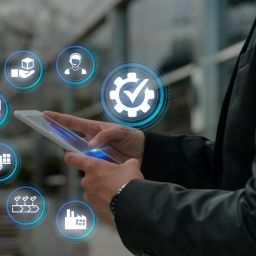If you are a doctor, run a clinic, or manage a hospital, you send many bills every day.e-invoicing in saudi arabia is the smart, fast way to handle these bills, making sure your business stays safe and organized.
HealthCluster is here to explain the e-invoicing meaning and show you exactly how e-invoicing works for your healthcare business in Saudi Arabia, the UAE, and globally.
What is E-Invoicing?
The simplest e-invoicing meaning is electronic invoicing. But it is more than just email!
An e-invoice is a bill that is created, sent, received, and processed using special computer language. The file itself is the bill, not just a picture of it.
This process is about computers talking directly to other computers. This removes all the manual work that causes delays and mistakes.
Difference Between E-Invoice and Digital Invoice
People often get these two confused. Let’s make it clear:
| Type of Invoice | What is it? | Computer Readability |
| Digital Invoice | A PDF or a scanned paper bill sent by email. | Low. A person has to read it and type the information into their system. |
| E-Invoice | A special file (like XML) with structured data. | High. Computers read the data instantly and automatically without any typing. |
The key difference is that an official e-invoice is ready for automation the moment it is created.
How E-Invoicing Works: A Step-by-Step Walkthrough
Understanding how e-invoicing works is easy when you look at the entire journey of the bill. This process is very important in places like KSA, where the government needs to see the bill instantly.
Step 1: Making the E-Invoice
First, you need to create the bill using special software, like the one from HealthCluster.
- Instead of making a simple paper bill, the software takes all the service details (the codes, the price, the patient name) and puts them into a special code format (e-invoice format).
- This format is called structured data. Think of it as putting the information into tiny digital boxes that a computer can open and read instantly.
Step 2: The Government Check (Clearance)
In many regions, especially the MENA region (like Saudi Arabia’s ZATCA), the bill doesn’t go straight to the customer.
- The software sends the e-invoice to the government’s online platform first.
- The platform quickly checks to make sure your e-invoice format is perfect and follows all the tax rules (compliance).
- If everything is correct, the government gives it a digital stamp of approval. This step is why e-invoicing is safer than manual invoicing.
Step 3: Sending to the Buyer
Only after the government checks the invoice does it go to the customer, the insurance company, or the business you are billing.
- The e-invoice is sent through a secure network or connection.
- Because the data is already structured, it goes from your software to the customer’s software instantly.
Step 4: Instant Processing
This is where you see the benefits of e-invoicing!
- The customer’s computer system reads the data automatically.
- It immediately knows what to pay, who to pay, and how much tax was charged.
- The bill is ready for payment faster, which means your business gets paid faster.
Benefits of E-Invoicing
Why should your clinic or hospital switch from e-invoicing to manual invoicing?
- You Get Paid Faster: Because there is no manual typing or delay, the payment cycle speeds up.
- Fewer Mistakes: Since computers do all the work, there are almost no errors in the billing amount or the tax calculation.
- Total Safety (Compliance): Your e-invoice is checked by the government and has a digital signature, making it safe from fraud. In places like KSA and the UAE, this means you avoid fines.
- Save Money: You spend less on paper, printing, and the staff time needed for data entry and chasing payments.
How to Generate E-Invoices
To generate e-invoices correctly, especially with strict rules like zatca e-invoicing compliance, you need the right tools.
- Use Integrated Software: Start with an EMR or accounting system that has a built-in e-invoicing feature. HealthCluster connects your patient records directly to the billing system.
- Enter Service Data: After a patient appointment, the service codes (like the CPT codes for a procedure) are entered into the system.
- Automatic Generation: The software automatically uses this information to create the correct structured data in the mandatory e-invoice format.
- Automatic Submission: The software handles the sending to the government and then to the customer—all automatically!
This seamless process is the best way to handle e-invoice examples in a high-volume healthcare environment.
E-Invoice Examples (Real World)
Imagine you run a specialty clinic:
| Scenario | Manual Invoicing | E-Invoicing |
| Billing an Insurance Company | – Staff prints the claim form, attaches a paper invoice, and mails it. – Insurer receives it days later and types the data to process the claim. | – HealthCluster automatically generates the e-invoice. – Sends the structured data to ZATCA for clearance. – Then sends it instantly to the insurer’s system. – The claim is processed in hours, not days. |
| Selling Products | – You sell a patient a mobility aid and give them a simple receipt. | – Your e-invoicing system generates a simplified e-invoice with a QR code and instantly reports the transaction to the tax authority. |
These examples clarify the choice between e-invoicing vs manual invoicing by highlighting the superior business efficiency that e-invoicing offers.
Conclusion
Understanding how e-invoicing works is the first step toward a smarter, safer future for your healthcare business.
The shift from manual invoicing to e-invoicing is no longer just about efficiency; it’s about mandatory compliance in key regions like KSA and the UAE.
By choosing a solution that truly automates the process, from creating the structured data to seeking government clearance, you ensure your invoices are always valid.
The ultimate benefits of e-invoicing are peace of mind, faster payments, and a future-proof operation.
Simplify your billing and ensure compliance today with Health Cluster!
FAQs
Q1: Is e-invoicing mandatory everywhere?
It is fully mandatory and strictly enforced in Saudi Arabia (KSA) under the zatca approved e-invoicing in saudi arabia system. The UAE and other GCC countries (like Qatar, Kuwait, Bahrain, and Oman) are moving toward mandatory adoption. Other countries like Australia and Indonesia also use specific government-mandated digital standards for business transactions.
Q2: What is the official e-invoice format?
The most common official e-invoice format is XML (Extensible Markup Language), often using a global standard like UBL (Universal Business Language). This is known as structured data. This format allows computers to read the information accurately.
Q3: How do you get paid when using e-invoicing?
E-Invoicing minimizes delays as the electronic bill is received and processed instantly by the buyer’s system. While the e-invoice itself doesn’t move the money, it creates the bill that triggers the fastest possible payment through regular bank channels, improving your cash flow.
Q4: Does e-invoicing work in Africa, such as Morocco?
Yes, many countries across Africa, including Morocco, are either piloting, planning, or actively implementing mandatory e-invoicing rules, often focusing on Continuous Transaction Control (CTC) models similar to the MENA region to fight tax fraud.
Q5: What is PEPPOL e-invoicing?
PEPPOL (Pan-European Public Procurement Online) is a widely used global network and set of specifications for safely exchanging e-invoicing documents. It’s a key standard for transactions, particularly in regions like Australia and Europe.





